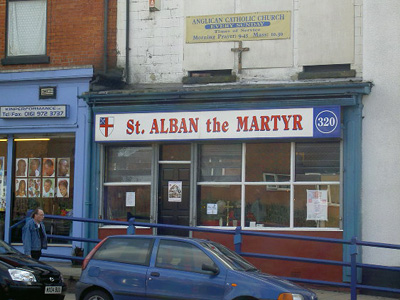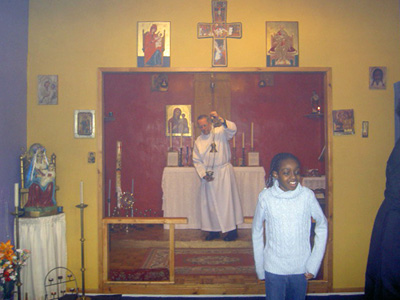 |
||||||||||
 |
||||||||||
|
1265: St Alban the Martyr, Salford, Greater Manchester,
England Mystery Worshipper: Back-to-Front. The church: St Alban the Martyr, Salford, Greater Manchester, England. Denomination: Anglican Catholic Church (Original Province). The building: Converted from a butcher's shop, the building is small and homely on the outside. Inside, however, it is most certainly a place dedicated to the worship of God, with all of the accoutrements of Catholic worship. I was especially pleased to see that they had made a rood above the entrance to the sanctuary by placing icons of St John the Forerunner and Our Lady on either side of an iconic representation of the Cross. The church: The Anglican Catholic Church was founded in 1977 when an international congress of Anglican bishops, clergy and lay people meeting at St Louis, Missouri, USA, voted to place themselves under the jurisdiction of the retired bishop of Springfield, Illinois, the Rt Rev. Albert Chambers. For the most part, they are former members of the Church of England who, for doctrinal reasons, felt increasingly disenfranchised after their church began to ordain women. Others of different backgrounds have joined them since then. The Diocese of England was formed in 1992. The parish of St Alban the Martyr is made up of people of different age groups and ethnic backgrounds who live locally and who travel in. The neighbourhood: The church is very close to Manchester city centre – a half-hour walk at most – and sits in the middle of a row of shops near the intersection of two main roads. As such, it is a busy and heavily trafficked area, with many people passing through each day. It can be a difficult area in terms of crime, which restricts the number of evening services that can be conducted at the church, but it is good to see a Christian presence here. The cast: The celebrant was the parish priest, the Rev. Charles Johnson, and the preacher was identified as Father Noel, whose surname I wasn't able to ascertain. The date & time: Saturday, 25 March 2006, 12.00pm. What was the name of the service? Sung Mass. The mass was but one part of a day of celebration of Lady Day. It had been preceded by matins and the angelus, and was followed by a shared lunch and an address. The day concluded with benediction of the blessed sacrament. How full was the building? As mentioned above, it is a small space. There were about 20 of us there and, while there could have comfortably been about that many over again, the numbers seemed just right somehow. We weren't tripping over each other but I certainly felt I was part of a community of worshippers. Did anyone welcome you personally? A number of people welcomed me, asking how I had come across them, including Mrs Johnson (the parish priest's wife) and another priest who had come to give an address after the service. Was your pew comfortable? It was a chair, and yes, it was fairly comfortable, as chairs go. In my own church we stand throughout, except for the sermon, when we sit, and then on the floor! As a result, no matter how accommodating the seating may be, I do tend to feel rather restricted when I revert to sitting in pews or chairs. How would you describe the pre-service atmosphere? Very chatty. There wasn't the reverent quiet that so often precedes Anglo-Catholic services. However, as many had travelled in specially, I suppose that people were talking to others they don't get to see very often. Also, the mass was but one service in a full day of events, and the crowd had already "warmed up" more so than on an average Sunday. What were the exact opening words of the service? Well, it's difficult to say. The service followed much of the structure of a tridentine mass, with the priest and servers praying quietly before the altar while we sang an opening hymn. I would guess that the opening prayers included the collect for purity, some versicles and responses, and the confiteor. What books did the congregation use during the service? A mass book specially produced by the Anglican Catholic Church, including their form of the mass (based on the Book of Common Prayer) with variations to make it follow a more traditional "western" shape. The other book was a hymnal – The English Hymnal, words edition, to be precise. This was good to see, especially in this famous hymnal's centenary year. What musical instruments were played? None. The singing was either unaccompanied or accompanied by a digital system which synthesised an organ sound (badly). Did anything distract you? Yes. The large "shop front" windows are wonderful in that they let a large amount of natural light into the church. They also make it a very hot place to be on warm days, which this day was. Also, the tridentine ceremonial superimposed on the Book of Common Prayer seemed a strange mix to me. It would probably have jarred less if it had been based on one solid tradition. I also found it a little strange that in such a festive remembance of Lady Day only one Marian hymn was used, but what a hymn – "Her virgin eyes saw God Incarnate born" to the tune of "Farley Castle." That more than made up for the absence of others. Was the worship stiff-upper-lip, happy clappy, or what? Formal but relaxed. The mass was offered in the traditional orientation, and so the gathered pilgrim people of God faced together toward the Lord rather than forming, say, a self-enclosed circle. There was definitely a sense of awe and reverence in the presence of the Almighty.  Exactly how long was the sermon? 15 minutes. On a scale of 1-10, how good was the preacher? 9 – This sermon was well-prepared and well-delivered. There were no mere notes, but it was written out in full, and yes, it was hand-written and not word-processed. In a nutshell, what was the sermon about? The Mother of God. This was the feast of the Annunciation, and Father Noel began with an explanation of the Archangel Gabriel's hailing of Mary as "full of grace." The Almighty Son of God chose Mary on whom to make himself completely dependent for his survival first as a foetus, then a baby, and then a child. He drew references to the intimacy of God with Moses in the story of the burning bush, and mentioned how, throughout much of the history of Christianity, the burning bush has been seen as a prototype of Our Lady, for it contained the presence of God and was not consumed. Mary's example is the one that we ought to follow, for her destiny is ours, but only by accepting the grace of God through faith can we claim it. Which part of the service was like being in heaven? Listening to the Gregorian canon. It has only been very infrequently used, if at all, in churches that I have attended, and so I do savour it whenever I hear it in one of its variations. And which part was like being in... er... the other place? I couldn't help but feel a certain sadness about the whole thing. Here is a church that is so intensely attuned to the worship of God, and yet a church that has but a few congregations scattered around the country. What happened when you hung around after the service looking lost? No chance of that. Father Johnson took charge of me to point out the various icons scattered about the church. I was then introduced to one of the younger members of the congregation, who asked me if I watched the popular BBC children's programme CBeebies. Finally I was directed to where the food had been set out. I mingled a little and talked to some of the regulars. They are truly lovely people. How would you describe the after-service coffee? The spread was a bring-and-share lunch. There were sandwiches, buttered scones, cakes, and all sort of other nice things of which I partook gladly. There was tea on offer but I'm one of those odd people who don't take either tea or coffee. How would you feel about making this church your regular (where 10 = ecstatic, 0 = terminal)? 8 – As it stands, I couldn't make this my regular church as I am firmly committed to my Orthodox beliefs. However, leaving that aside, if this were an Orthodox church, I think that I could feel very much at home here. There are not really that many differences between what they believe and what I believe. Although they do use a form of the Western rite, it was not completely unfamiliar to me. They seem like wonderful people, and I shall certainly be visiting again. Did the service make you feel glad to be a Christian? Yes. In an age where many churches are compromising on matters of faith for the sake of a false ecumenism, my heart was warmed to see a group of people who have been willing to give up the security of ornate historic buildings, guaranteed paid clergy, and the respectability of establishment, in order to live according to what they understand to be the Truth of Christ. Regardless of whether I agree with their original reasons for leaving their original churches, I cannot help but be moved by this. What one thing will you remember about all this in seven days' time? The Gregorian canon. |
|
|
||||||||||||||||||||||||||||||||||||
| More Mystery Worshipper reports | |||||||||||||||||||||||||||||||||||||||
 |
|||||||||||||||||||||||||||||||||||||||






